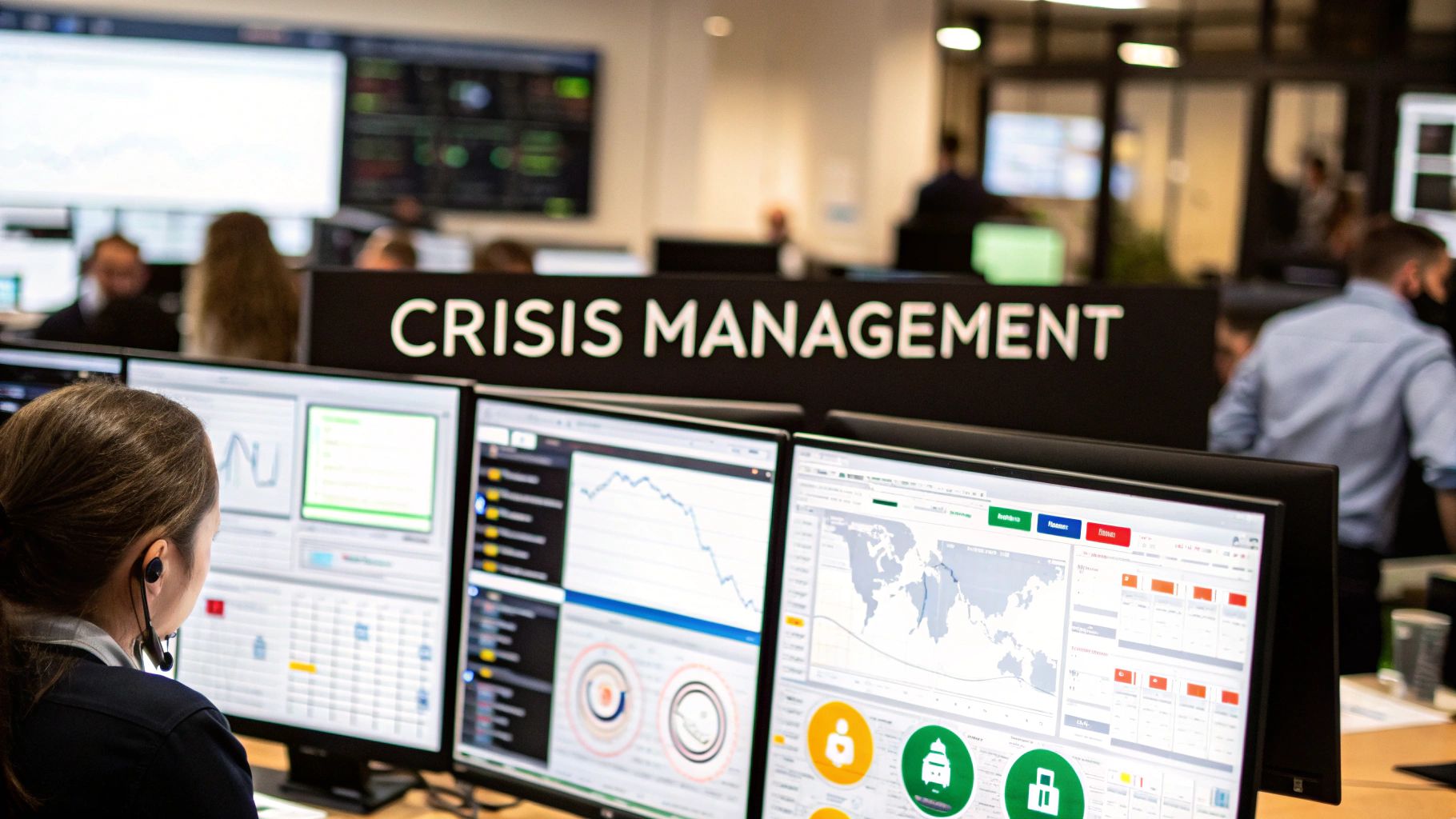
Social Media Crisis Management Guide
A practical social media crisis management guide to protect your brand. Learn proven strategies for response, reputation repair, and prevention.
Social media crisis management is all about being prepared. It's the game plan for identifying, managing, and resolving brand-threatening problems on social platforms before they do serious damage. This isn't just a "nice-to-have" strategy; it's a must. A single negative post can snowball into a full-blown reputational disaster in minutes, making a proactive plan essential for survival.
Why a Crisis Plan Is Your Brand's Lifeline
Let's be real—a social media crisis isn't a matter of if, but when. One poorly worded tweet, an overlooked customer complaint, or a product hiccup can spiral out of control with terrifying speed. Without a plan, teams are thrown into a chaotic scramble, making mistakes under pressure that only pour fuel on the fire.
A well-defined crisis management plan is what separates a controlled, measured response from a frantic, brand-damaging panic. It gives you the framework to act decisively, communicate clearly, and protect the trust you’ve worked so hard to build. Think of it as an emergency playbook for your brand’s reputation.
This flow chart breaks down the core stages of an effective crisis response, from the initial spark to the final resolution.
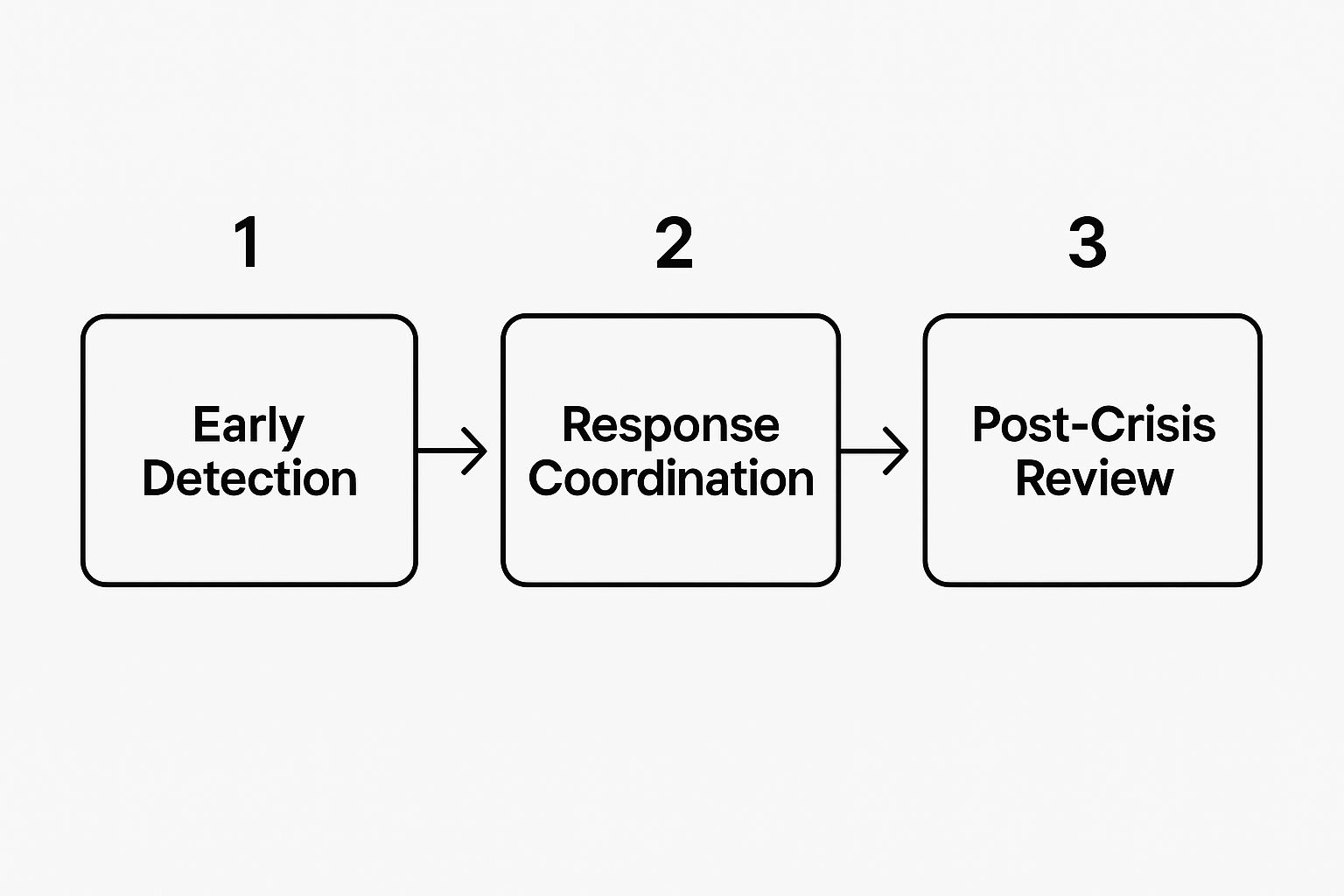
The process shows how a structured approach—moving from early detection to a coordinated response and then a post-crisis review—is key. It prevents chaos and ensures every move you make is a strategic one.
Understanding the crisis lifecycle gives you a clear roadmap for navigating from detection to recovery. Each phase has a distinct goal and set of actions that guide your team.
The Four Phases of Social Media Crisis Management
| Phase | Primary Goal | Key Actions | | :--- | :--- | :--- | | 1. Preparation | Proactive Planning | Risk assessment, create response plan, train team, set up monitoring tools. | | 2. Response | Control the Narrative | Acknowledge the issue, communicate transparently, engage with stakeholders. | | 3. Resolution | Mitigate Damage | Implement solutions, provide updates, demonstrate accountability. | | 4. Recovery | Rebuild Trust | Analyze performance, refine plan, monitor brand sentiment long-term. |
By breaking down a crisis into these four stages, you can tackle the situation methodically instead of reacting emotionally.
The New Reality of Brand Risk
This isn't just theory. Social media crises are a common business challenge, with 69% of companies experiencing at least one incident every five years. The triggers are all over the map—from customer complaints and product failures to controversial company policies.
This high frequency means that operating without a crisis strategy is like trying to navigate a storm without a map or a compass. You can learn more about social media crisis trends and see just how much they impact modern businesses.
A crisis doesn't create character, it reveals it. When your brand is under fire, your audience isn’t just watching what you say; they’re judging how you say it and how quickly you take ownership.
The Role of Proactive Monitoring
Great crisis management starts long before things go wrong. It begins with listening. Tools that give you deep visibility into brand mentions, sentiment shifts, and emerging conversations are your first line of defense. For instance, a platform like ViewPrinter can centralize your social listening, flagging potential issues before they gain any real momentum.
This kind of visibility is a game-changer. It allows you to:
- Catch Negative Sentiment Early: Jump on customer complaints before they go viral.
- Track Emerging Narratives: Get a real-time pulse on what people are saying about your brand.
- Prepare Your Response: Buy your team precious time to gather facts and craft a thoughtful reply.
Ultimately, a crisis plan isn’t a document you create once and then file away. It's a living, breathing strategy that gives your team the power to protect your brand’s most valuable asset: its reputation.
Building Your Defense Before the Crisis Hits
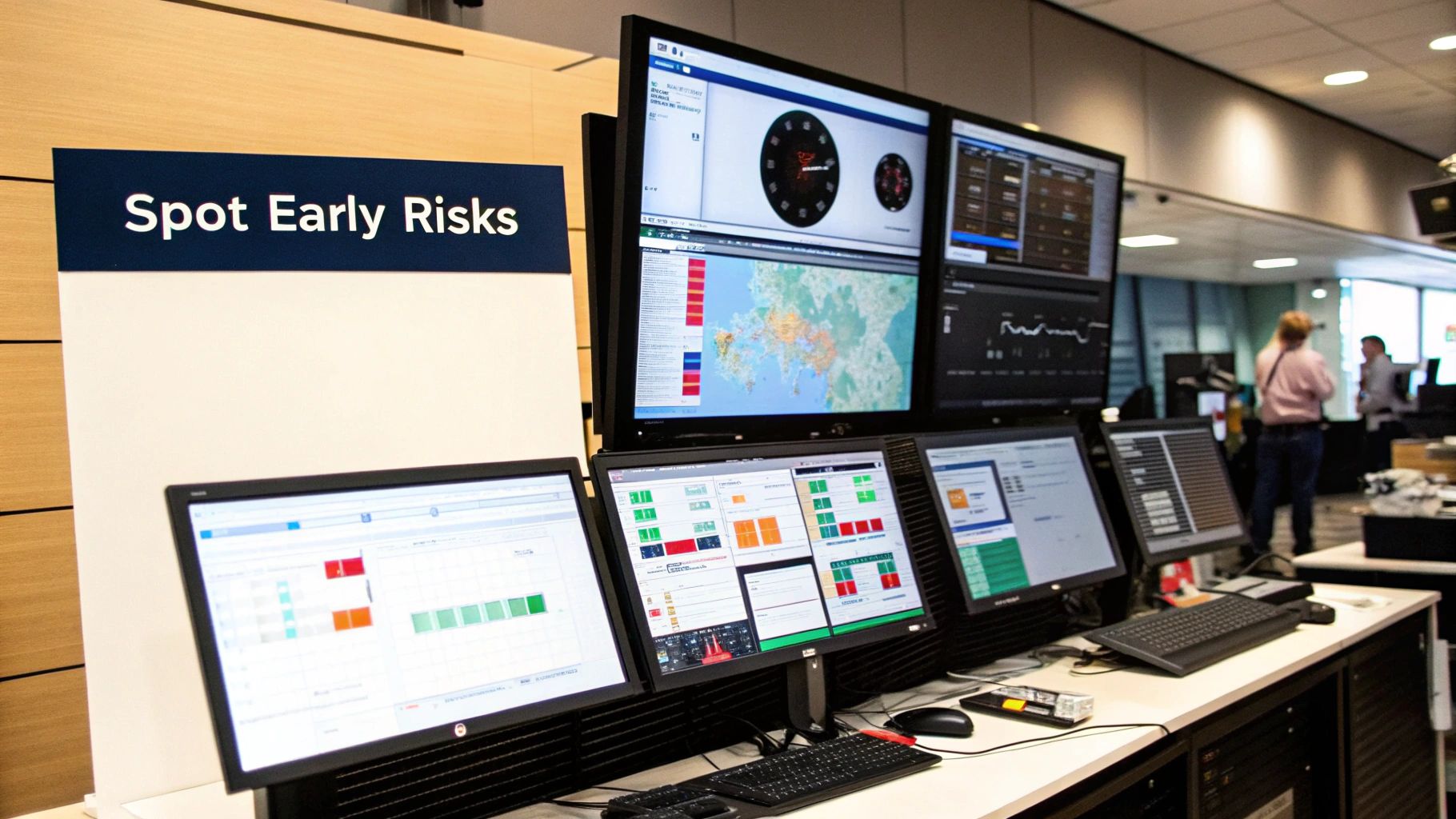
The best way to manage a social media crisis is to prepare for it long before one ever happens. Seriously. This is the work you do before things go wrong that separates a measured, strategic response from a frantic, panicked reaction.
It’s all about creating order now so that chaos doesn’t get a chance to take over later. And that work starts with getting the right people in the room.
Assemble Your Crisis Response Team
A crisis isn’t just a social media problem; it’s a business problem. That means your response team needs to be more than just your social media manager. You need a small, cross-functional group that sees the issue from every critical angle.
When the pressure is on, there can be zero confusion about who’s in charge or who signs off on what. Your core team should look something like this:
- Team Lead: The quarterback. This person coordinates the entire response and keeps everyone on the same page.
- Social Media Manager: Your eyes and ears on the ground, monitoring the conversation and executing the communications plan.
- PR/Communications: The expert responsible for crafting and approving every public message. They own the narrative.
- Legal Counsel: The sanity check. They make sure your statements don't create unnecessary legal risks.
- Customer Support Lead: The voice of your customer. They bring invaluable insight into what people are actually saying and feeling.
The most important part? Map out your approval process now. In the middle of a firestorm, you can’t waste precious minutes figuring out who needs to approve a tweet. A clear flowchart ensures you can move fast without making things worse.
Develop Your Early Warning System
You can’t respond to a fire you can’t see. This is where social listening becomes your smoke detector. It’s your best, and sometimes only, line of defense.
Using a tool like ViewPrinter, you can set up dashboards to monitor brand mentions, track sudden shifts in sentiment, and catch spikes in negative keywords the moment they happen. This isn't just a nice-to-have; it's a necessity.
The market for social media crisis management services shot past USD 1.88 billion in 2023 for a reason. Brands are investing heavily in AI-powered tools because real-time analytics are no longer optional. It’s also a good time to double-check that your basic defenses are solid, like your social media privacy settings, which can prevent vulnerabilities that might trigger a crisis in the first place.
A holding statement is your best friend in the first 30 minutes of a crisis. It’s a pre-approved, neutral message that buys you time to gather the facts. It simply says, "We see this, we're taking it seriously, and we'll share more information as soon as we have it."
Create Pre-Approved Messaging Templates
Trying to draft the perfect message from scratch while your mentions are on fire is a recipe for disaster. That’s why you need to prepare for common scenarios ahead of time. Think of these less as copy-paste responses and more as solid starting points that are already aligned with your brand voice.
Your crisis playbook should be stocked with templates for:
- Holding Statements: For acknowledging an issue immediately when you don't have all the answers yet.
- Apology Templates: For when you're clearly in the wrong and need to take full ownership.
- Fact-Correction Messages: For shutting down misinformation with clear, verifiable proof.
- Service Outage Updates: For keeping customers in the loop during technical hiccups.
Every template should feel true to your brand. If you don’t have a defined communication style, now’s the time to build one. Creating your social media brand guidelines is the final piece of the puzzle. This preparation is what empowers your team to act, not just react.
Navigating the First 60 Minutes of a Crisis
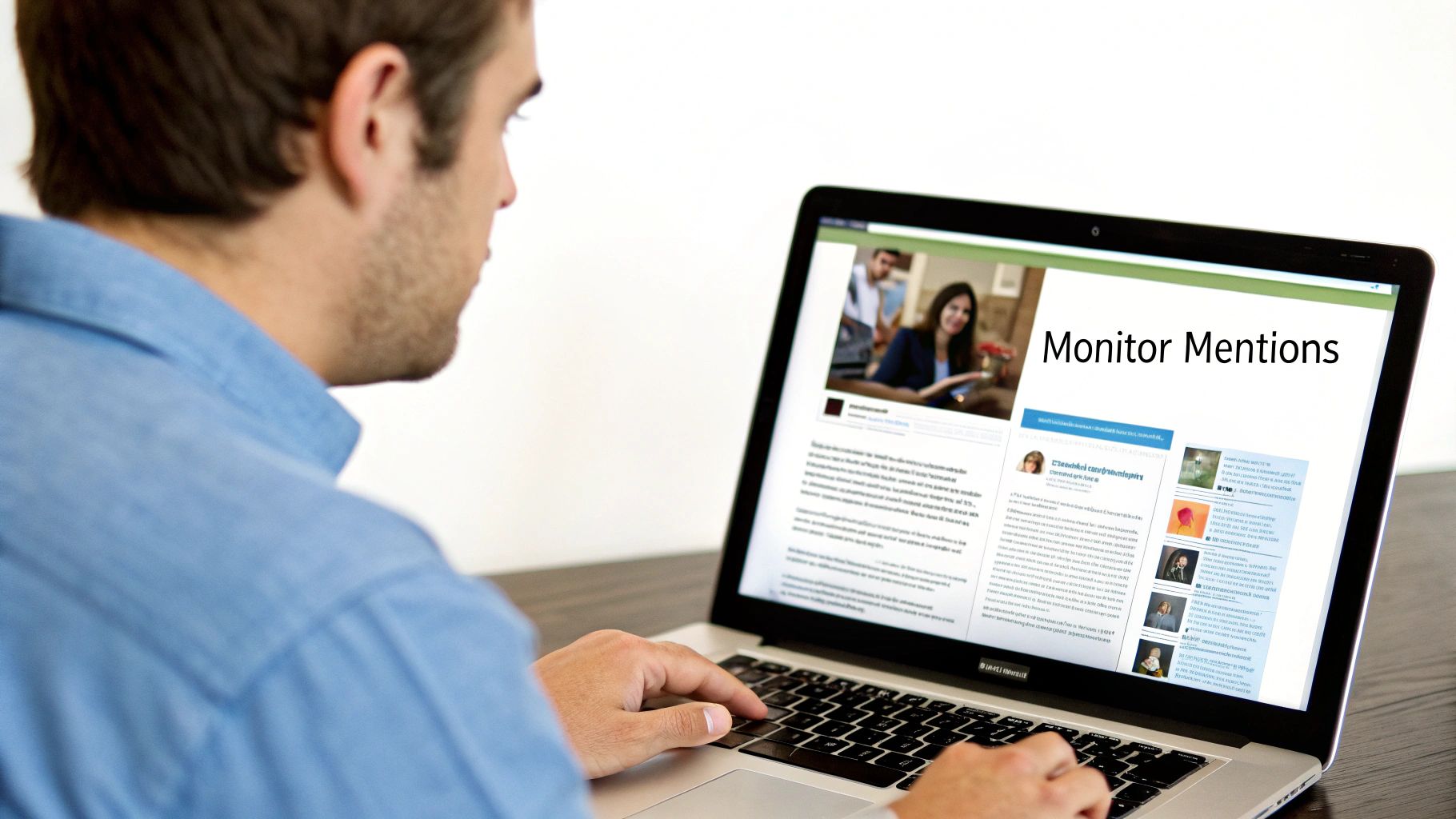
When a social media crisis hits, the clock starts ticking. Loudly. That first hour isn't just important—it's everything. It’s your one real chance to get ahead of the narrative before it snowballs into a full-blown disaster for your reputation. A slow, clumsy, or tone-deaf reaction can pour gasoline on the fire.
The very first thing you need to do has nothing to do with writing a response. You have to immediately pause all scheduled social media content. Seriously, drop everything and do this first. Nothing torpedoes a sincere apology faster than a cheerful, pre-scheduled promotional post popping up right next to it. It’s a simple but non-negotiable step that shows you’re all hands on deck. If you need a refresher, our guide on how to automate social media posts also touches on the critical skill of knowing how to hit the pause button.
Your First Public Statement
Okay, all scheduled posts are frozen. Now what? Your next move is a swift public acknowledgment. Silence is your worst enemy. It creates a vacuum, and you can bet that speculation, anger, and misinformation will rush in to fill it.
Your initial response doesn’t need to have all the answers. It just needs to be fast, empathetic, and human. This is absolutely not the time for corporate jargon or defensive posturing. Get rid of phrases like "we regret any inconvenience" or "this situation is being investigated."
Instead, lead with ownership and empathy. A solid initial statement should:
- Acknowledge the issue head-on. Show you’re aware of what’s happening.
- Express genuine empathy. Let people know you understand why they're upset.
- Confirm you're taking it seriously. Reassure everyone that this is your top priority.
- Promise a follow-up. Set a clear expectation for when you'll provide more information.
The goal of your first response is not to solve the problem—it’s to show you’re listening. Acknowledging the issue quickly demonstrates respect for your audience and buys you the critical time needed to gather facts and formulate a more detailed plan.
Putting It Into Practice
In a crisis, speed, transparency, and authenticity are your guiding principles. A textbook example of this done right was when Target experienced a massive data breach. The CEO didn't hide behind a carefully worded press release. Instead, he posted a video message to social media within hours.
He apologized sincerely, explained what they were doing to fix the immediate problem, and offered free identity protection to everyone affected. That rapid, direct communication was crucial for keeping customer trust from completely eroding.
This is where a platform like ViewPrinter becomes your command center. You can quickly draft, get approval, and publish that holding statement, ensuring the message is consistent across all channels, even when you're under immense pressure.
During that first hour, your team should also be glued to your social listening tools, monitoring the conversation's volume, velocity, and sentiment. This data is pure gold—it tells you how big the fire is and helps you decide where to point the hose next. The moves you make in this first 60 minutes will set the tone for everything that follows.
Managing the Conversation and Guiding the Narrative
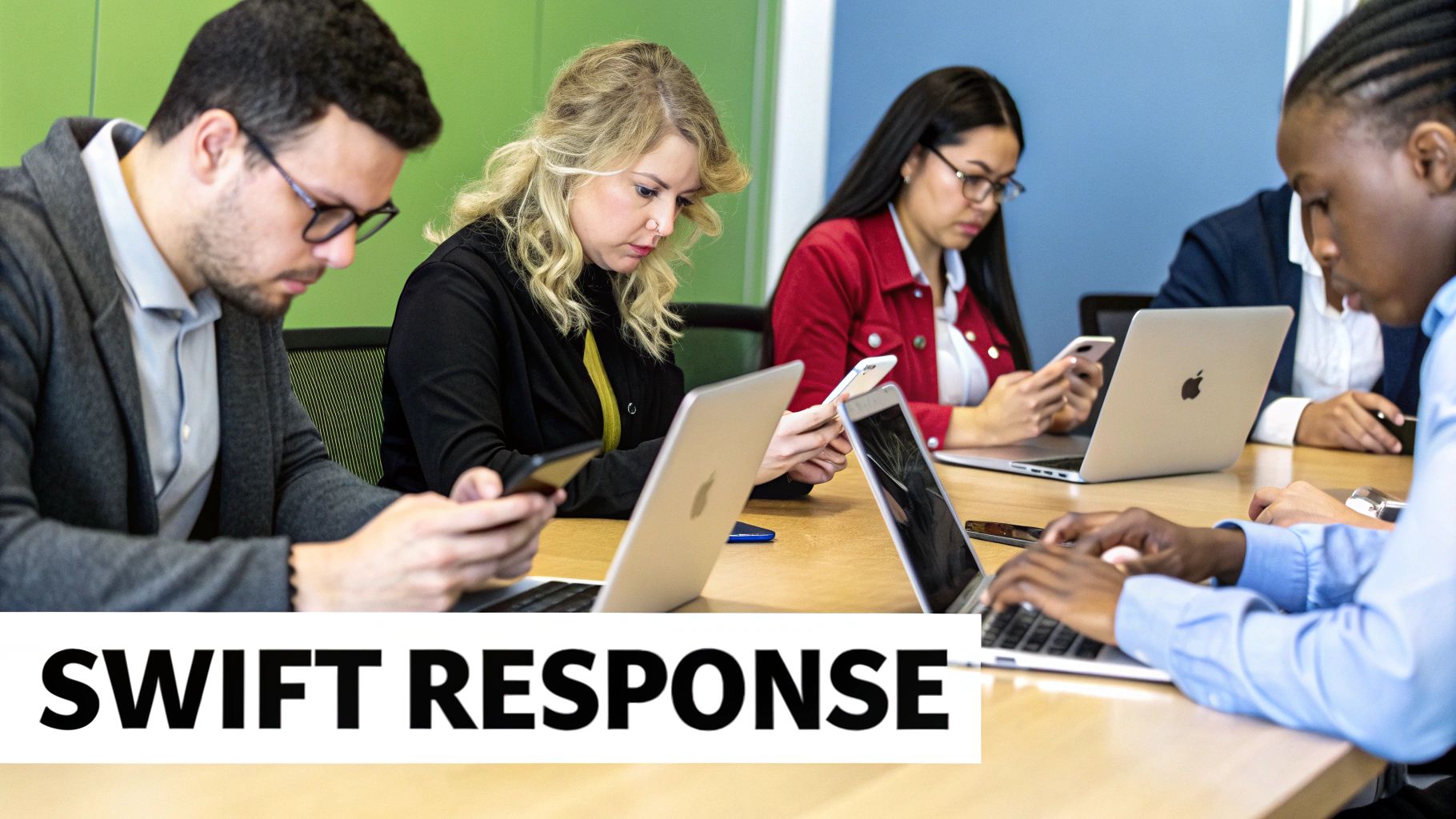
Okay, you’ve put out the initial fire with a quick, honest response. Now the real work begins. This phase is all about moving from frantic damage control to a more deliberate, controlled resolution. It’s time to actively guide the narrative from chaos back toward clarity.
One of the toughest calls you'll make is deciding who gets a direct reply. You can't—and shouldn't—respond to every single comment. It's just not practical, and it can actually make things worse. Instead, focus your one-on-one engagement where it has the most impact: with influential accounts, genuine customers asking for help, or people spreading dangerous misinformation that needs correcting.
Create a Single Source of Truth
As a crisis picks up steam, you'll get hit with the same questions over and over again. This clogs up your feeds and buries your important updates. The best way to handle this is by creating a central hub for all information.
This could be a dedicated landing page or a detailed FAQ on your website that becomes your single source of truth.
Make sure this page includes:
- A Clear Summary: A brief, no-fluff overview of what’s happening, based on what you know right now.
- Answers to Common Questions: Keep this section updated in real-time as new questions pop up.
- Official Statements: A running timeline of all the public communications you've released.
- Next Steps: Let people know what you're doing to fix the problem and when they can expect the next update.
Once this hub is live, your social media team has a link they can share, rather than retyping the same answers a hundred times. This frees up your social channels for empathy and high-level updates, not repetitive support tasks. This kind of organized approach is a cornerstone of solid social media crisis management, especially when you consider the impact of social media on your brand's reputation and legal standing.
The goal is to funnel the conversation from your chaotic social feeds to a controlled space where you can present the facts clearly. A central hub puts you back in the driver's seat.
Use Your Monitoring Tools Strategically
Throughout this phase, your social listening tools are your best friend. You're not just looking for that initial spike in mentions anymore; you're tracking how the conversation is evolving.
Pay close attention to sentiment shifts. Is the initial anger starting to fade? Is it being replaced by confusion? This data is your report card—it tells you if your messaging is hitting the mark. If negative sentiment keeps climbing, that’s a flashing red light that your response isn't working and you need to pivot. You can get a better handle on this by understanding social media analytics.
At the same time, keep an eye out for positive voices. Brand advocates and loyal customers who step up to defend you are gold. Engage with them, thank them, and amplify their messages when it makes sense. Their authentic support often carries more weight than anything you could say yourself. This is how you start to steer the conversation, not just react to it.
Turning Crisis Into a Catalyst for Growth
Once the dust settles on a social media crisis, it's tempting to just breathe a sigh of relief and move on. But don't. The immediate fire might be out, but the most important work is just getting started. This post-crisis period is your golden opportunity to learn, rebuild, and come out the other side much stronger.
When you treat a crisis as a learning experience, it stops being just a negative event and becomes an investment in your brand's future resilience. Think about it: research shows that 72% of consumers will actually stick with a brand that handles a crisis quickly and sincerely. That alone shows you how powerful a thoughtful recovery can be.
Conducting a No-Blame Post-Mortem
First things first: you need to hold a post-crisis analysis. This isn't about pointing fingers or figuring out who to blame. It’s a "no-blame" review focused entirely on the process, not the people. The only goal is to figure out exactly what happened, why it happened, and how you can stop it from happening again.
Get your crisis team in a room and start asking the hard questions.
- Detection Speed: How fast did we actually spot the issue? Did our social listening alerts catch it, or did we find out from an angry mob in our mentions?
- Response Time: What was the lag time between spotting the problem and our first public comment? Where were the holdups in our approval chain?
- Message Resonance: Did our statements actually calm things down, or did we accidentally pour fuel on the fire? Did sentiment scores go up or down after we weighed in?
- Tool Performance: Did our platform, like ViewPrinter, give us the data we needed when we needed it? Could we easily track sentiment, manage all the incoming responses, and work together as a team?
Getting honest answers here will show you exactly where the cracks are in your crisis management plan.
Your post-crisis report is more than just a recap of what went wrong. It's a blueprint for what you'll do right the next time. Use it to tighten up your playbooks, update your training, and reinforce your defenses.
Rebuilding Trust With Transparency
After you've done the internal review, it's time to face outward again and start rebuilding trust with your audience. This takes more than just hoping people move on and forget. You have to be proactive and transparent.
A great place to start is by sharing what you’ve learned and what you’re changing because of it. A simple follow-up post or blog article that says, "We listened, and here's what we're doing differently," is incredibly effective. It shows you’re accountable and that you actually care about your community’s feedback. Maybe you announce new training protocols for your support team or an extra quality check for your products—whatever it is, share it.
This is also the time to keep a close eye on your brand’s health. Track your key metrics to see if your recovery efforts are actually working.
Key Recovery Metrics | Metric | Why It Matters | | :--- | :--- | | Sentiment Score | Measures the overall tone of conversation around your brand, showing if public perception is improving. | | Share of Voice | Tracks how much of the conversation in your industry is about you versus competitors, post-crisis. | | Audience Growth Rate| Indicates if you are retaining and attracting followers, a key sign of trust being restored. |
At the end of the day, a crisis doesn't have to be the thing that defines your brand. By digging into what happened, owning the lessons, and showing your commitment to doing better, you can turn a moment of weakness into a massive catalyst for long-term growth and loyalty.
Your Social Media Crisis Management FAQs
When things go sideways on social media, questions start flying fast. Here are the real-world answers to the questions I hear most often from teams in the hot seat.
What Is the First Thing We Should Do?
Before a single word of a response is written, your very first move is to pause all scheduled social media posts. Immediately.
Nothing tanks a crisis response faster than a cheerful, pre-scheduled promo post popping up while your brand is on fire. It looks careless at best and downright insulting at worst. Hitting pause shows everyone you’re taking the situation seriously and focusing all your attention on it.
Once that's done, get your crisis team together. This isn't the time for a slow email chain. You need your key people—PR, legal, support, and leadership—in a room (or a video call) right away to get a handle on the situation and agree on an initial holding statement.
Should We Delete Negative Comments?
I get this question all the time, and the answer is almost always a hard no.
Deleting negative comments is like pouring gasoline on a fire. It screams, "We're hiding something!" and instantly makes you look guilty, even if you aren't. It shifts the conversation from the original problem to a new one about censorship, which can rally even more people against you.
The only exception? When a comment directly violates your community guidelines. This includes things like:
- Hate speech, harassment, or direct threats
- Obvious spam or links to malicious sites
- Posting someone's private information
If you have to remove a comment for one of these reasons, always take a screenshot first for your internal records.
Deleting valid criticism is a fast track to destroying trust. Letting it stand—and even engaging with it—shows you’re transparent and strong enough to handle the heat.
How Do We Know When a Crisis Is Over?
A crisis isn't over just because you've stopped talking about it. The real signal comes from your audience and the data. You’ll know the storm has passed when the public conversation shifts back to normal.
Look for a few key signs in your analytics. First, your social listening tools should show a major drop in the volume of negative mentions. Second, the overall sentiment score for your brand will start to creep back up toward its normal baseline.
Finally, you'll see engagement on your regular, non-crisis content start to pick up again. Trust the data, not your gut, to tell you when it's safe to move forward.
Ready to build a crisis-proof social media strategy? With ViewPrinter, you get a unified platform to monitor conversations, create on-brand content, and respond with speed and precision when it matters most. Take control of your brand’s narrative and turn potential crises into opportunities to build trust. Explore the tools that top teams use at https://viewprinter.tech.